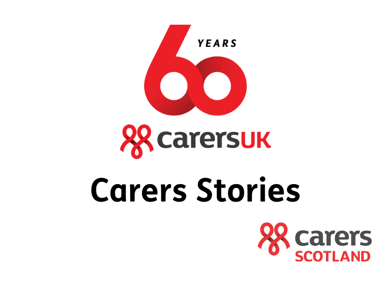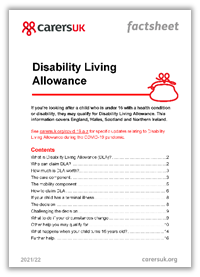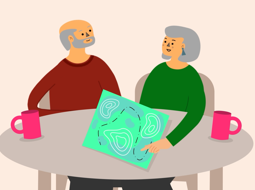Disability Living Allowance (DLA)
What is DLA?
If you are looking after a child with a health condition or disability who is under 16, they may be entitled to a benefit called Disability Living Allowance (DLA).
If they are 16 and over, they might be eligible for Personal Independence Payment (PIP) instead.
DLA is extra money you might be able to claim for your child if they have a health condition or physical or mental disability and are under 16. They must need care, attention or supervision but they do not need to have an actual diagnosis from a doctor.
In Scotland, a new disability benefit called Child Disability Payment has been introduced and replaces Disability Living Allowance. It is administered by Social Security Scotland and you can find out more at: mygov.scot/child-disability-payment
Find out about the rules for claiming DLA to see if the child you’re looking after might qualify.
Frequently asked questions about DLA
DLA is not means-tested. This means that when a review takes place to see if you are eligible, your income or savings (or any savings your child has) are not taken into account.
DLA is a tax-free benefit so you will not have to pay tax on it if you qualify.
DLA won’t reduce any other benefits you’re receiving. In fact, it could even increase them. It may also help you qualify for certain benefits, such as Universal Credit or Carer’s Allowance, and it could increase any tax credit award you receive.
You and the person(s) you care for may be entitled to other extra support too.
There are two components: care and mobility. For 2025/26, the weekly rates for each are as follows:
| Lower | Middle | Higher | |
| Care component | £29.20 | £73.90 | £110.40 |
| Mobility component | £29.20 | n/a | £77.05 |
If you care for a child under 16, they would be eligible for DLA if all the following apply:
- They need care because of having a health condition or mental or physical disability.
- They’ve needed this care, attention or supervision for at least three months before claiming, and expect this need to continue for at least six months after claiming.
- They need substantially more care, attention or supervision than children of the same age without a health condition or disability.
Your child would also need to meet certain conditions related to their residence and presence in the UK.
The Advicelocal website has details of local services.
If your child is subject to immigration control, get specialist advice before making a claim as a claim might affect their right to stay in the UK.
If your child is terminally ill, there are simpler rules that make it easier to apply. See our guidance.
It is a good idea to start by considering the two components of DLA:
- Care component – for help with personal care
- Mobility component – for help with getting around
In order to qualify, your child will need to be under 16 and will have more extensive needs in these areas than a child of the same age without a disability or health condition.
How much you are paid depends on your child’s level of need. See ‘What’s the care component’ and ‘What’s the mobility component?’ below for more details. To be eligible, at least one of these components must apply to you.
If the child you are caring for is terminally ill, special rules apply which can make the process easier and quicker.
If a child is claiming DLA, they will need to claim PIP once they reach 16 (unless they’re claiming DLA under special rules for terminal illness).
The guardian of the child will be contacted by the DWP or Disability and Carers Service (if in Northern Ireland) to explain this if their child is coming up to 16 years of age. They will check whether their child will continue to need an appointee to act on their behalf.
There are three rates:
- Lower rate: for children who need help with personal care for a signification proportion of the day (which generally means one hour – although this does not necessarily have to be all at once)
- Middle rate: for children who have daytime or night-time needs (special rules apply for children undergoing dialysis at least twice a week)
- Higher rate: for children who have both daytime and night-time needs. They will automatically get the higher rate if they are terminally ill.
If your child needs help getting around, they may qualify for the mobility component which has two parts.
You need to show that your child is unable or virtually unable to walk and/or needs substantially more guidance and supervision than a child of the same age without a disability or health condition.
- The lower rate mobility component can be paid to a child from the age of five years. It is for children who can walk but who need extra guidance or supervision on unfamiliar routes outdoors.
- The higher rate mobility component can be paid to a child from the age of three years. It is for children who are unable, or virtually unable to walk, or where the exertion required to walk would constitute a danger to their life or would be likely to lead to a serious deterioration in their health. Children can also qualify if they have a severe visual impairment, are both deaf and blind, or are severely mentally impaired.
For more details, see our Disability Living Allowance factsheet.
Step one: You can make an initial claim by calling the Disability Living Allowance Helpline on 0800 121 4600 (textphone: 0800 012 1574).
Visit the GOV.UK website to download a claim form. In Northern Ireland, call the Disability and Carers Service on 0800 587 0912 (textphone 0800 012 1574).
Visit nidirect.gov.uk/dla to download a claim form.
Step two: When you are ready to complete the form, see our 'Tips for completing the form' in the tab below to help.
- It’s a long and detailed form so take your time to complete it – you don’t have to do it all in one go. If needed, ask for help from a local advice agency. You can find one on the Advicelocal website.
- List all of the help your child needs before completing the form.
- Try keeping a diary for a week if you’re not sure how much help your child needs or how long things take.
- Say how often your child needs help rather than how often they get help. Point out any adjustments you’ve also already made to help.
- Try to focus on the difficulties and extra support your child needs compared with other children of the same age.
- Explain if their condition or disability affects them in other ways – such as causing anxiety or lack of confidence.
- Try to use examples where possible – don’t just rely on the tick boxes. Assume the person looking at the form knows nothing about the disability or condition.
- There’s a section called ‘Statement from someone who knows the child’. Include the details of a relevant professional here (ie/ school teacher, GP, therapist etc) who could write knowledgeably about your child.
- If you include the details of one or more professional, make it clear which one knows your child best.
- Also notify the professional if you are including their details as they may be contacted for further details.
- Keep a copy of your form and any evidence you send in. It will be useful during your assessment, or if you need to appeal.
The Citizens Advice website has further useful advice on how to complete the form.
Note: If your child is terminally ill, you won’t have to complete the ‘How your disability affects you’ form. Read claiming a disability benefit if terminally ill for more details.
See our benefit adviser's video tips for further guidance on how to complete the claim form.
Once you’ve sent off the form, you should hear from the Department for Work and Pensions or the Disability and Carers Service within two weeks to let you know that they’ve received the form. Contact the DLA helpline if you haven’t heard anything after two weeks. You will normally be notified of their decision within three months.
Next, you will receive a written decision about whether your child has been awarded DLA and what rates they are eligible for and from what date.
You may receive DLA for your child for a specific period or for an indefinite period. If it’s for a fixed period, you should receive another claim form well before the end date.
If your child is terminally ill, the process is different – see our guidance for those who are terminally ill for more information.
If you’re turned down, or awarded the lower rate when you think you should get the enhanced rate, it is best to act quickly if you wish to challenge the decision.
See our page on challenging a benefits decision.
If your child has been awarded DLA, there are a number of other benefits you might be able to receive in addition or it could boost any existing ones you’re receiving:
- DLA and Child Tax Credits. Child Tax credit is assessed more generously when a child receives DLA.
- DLA and Income Support. If you’re already receiving Income Support, you may qualify for a disabled child premium or an enhanced disability premium.
- DLA and Universal Credit is assessed more generously when a child receives DLA.
- DLA and Housing Benefit: If your rent isn’t covered in full through Housing Benefit, you may be awarded a higher rate.
If your child is now receiving DLA, you may become eligible for Housing Benefit if you weren’t previously.
- If your child receives DLA, you will be exempt from the benefit cap.
- You may be entitled to Carer’s Allowance if you weren’t before if your child receives DLA.
- You may now be able to get travel-related benefits such as parking discounts through the Blue Badge scheme, public transport concessions and help through the Motability scheme if you need to drive.
For further information about these benefits, see our Disability Living Allowance factsheet. Also see ‘What other help is available?’ below.
You need to tell the DWP (or Disability and Carers Service in Northern Ireland) as soon as possible if your child’s condition or circumstances change, because this could affect your entitlement to DLA.
A change in their condition could include:
- their illness or disability getting better or worse
- changes to the level of help they need with daily living or mobility
- they’re going into a care home* or residential school for more than 28 days. If they’re under 18 and going into hospital, their DLA won’t be affected. For more information, see our DLA factsheet.
*The rules that apply are different if the stay is funded by NHS Continuing Healthcare or if you fund the care home yourself.
If you’re paid the lower rate of DLA for either part and the help you need increases, you can contact the DWP (Disability and Carers Service in Northern Ireland) and ask for your case to be looked at again.
Be aware there is always a risk that your benefit could be decreased rather than increased, so it’s a good idea to get help from a local advice agency first. Visit the Advicelocal website to find one.
You can find out which benefits you’re entitled to and how much you should be getting by doing an online benefits check, or contact one of our advisers at advice@carersuk.org for help arranging one.
Exemption from the benefit cap
The benefit cap is a limit on the total amount of benefit your household can receive. Getting DLA means your household won’t be affected by the benefit cap.
Help with transport costs
If claiming DLA for your child, there are many ways you can get help to reduce your transport costs.
Motability. If your child receives the enhanced rate mobility part of DLA, you may be able to apply to the Motability scheme. This lets you use the mobility part to rent or buy a car, wheelchair or scooter. You may also qualify for a grant to pay for driving lessons or for a deposit for a car. Contact Motability to find out more.
Blue Badge scheme. The Blue Badge scheme helps you park closer to your destination if you have difficulty walking. For example, a Blue Badge lets you park free at parking meters and in pay and display areas.
If your child is awarded the higher rate mobility component of DLA, you may be eligible for a Blue Badge. Contact your local council or trust for further information.
Exemption from road tax. You may not have to pay road tax if you get the enhanced mobility rate of DLA. If you get the standard mobility rate, you may get a 50% discount on your road tax. Visit GOV.UK for how to apply.
Money off train travel. You can buy a Disabled Person’s Railcard to cut train fares for you and a friend. Call 0345 605 0525 or visit the Disabled Person's Railcard website. This isn’t available in Northern Ireland.
Help with the cost of public transport. You may be eligible for public transport concessions if you receive PIP. Eligibility is different depending on where you live in the UK. Contact the following for more information.
England
Contact your local council.
Wales
Visit the Transport for Wales website (https://portal.tfw.wales/en) or call them on 0300 303 4240
Scotland
Contact Transport Scotland on 0141 272 7100 or your local authority. You may also be entitled to a Companion Card, allowing someone to travel with you for free.
Northern Ireland
Contact Translink on 0845 600 0049 or your local trust.
Further help
Our Disability Living Allowance factsheet provides more information and, at the end, it contains a listing of organisations that offer further specialist help and support.
For a helpful overview, watch our Carers UK taster video.
There is also a detailed DLA video playlist available. This breaks down the information with the following topics:
- An overview
- How to claim
- After you have claimed
- When a child turns 16
Sign language versions
The videos are also available as British Sign Language versions using two translators having a conversation in British Sign Language (BSL).
See: British Sign Language videos playlist
Easy read versions
Easy read versions of the content are available through GOV.UK.
Latest updates

60th Anniversary Stories: In Praise of Young Carers – Pearls (Poem)

Carers Scotland 60th Anniversary Reception and Exhibition

Government confirms benefit increases for 2026-27, including rise in Carer’s Allowance and earnings threshold
Got a question about caring?
Every day we hear from people who need help with looking after a friend or family member
Become a member for free
Joining Carers UK is free and takes just a few minutes.




